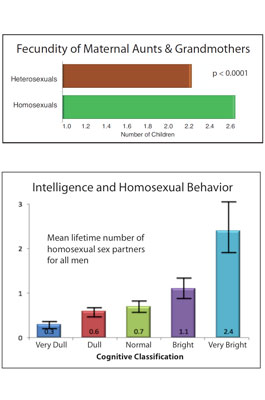“Homosexuality may give advantages to the group by special talents, unusual qualities of personality, and the specialized roles and professions it generates. There is abundant evidence that such is the case in both preliterate and modern societies. Societies are mistaken to disapprove of homosexuality because gays have different sexual preferences and reproduce less. Their presence should be valued instead for what they contribute constructively to human diversity. A society that condemns homosexuality harms itself.” — E. O. Wilson (2012)
THROUGHOUT recorded history, homosexuals have comprised a small but significant cohort of human society. Evidence of same-sex sexual behavior dates back to the oldest written texts, first noted in Egypt 4,400 years ago, and subsequently found in ancient Greece, Rome, and China. Additionally, same-sex mating behavior has been documented in a broad range of animal species, including mammals, birds, reptiles, and insects. In Western countries today, the prevalence of male homosexuality is between two and eight percent. Nevertheless, same-sex physical intimacy is illegal in many nations, with punishments including death or imprisonment. The law in India, put in place by British colonizers, calls for imprisonment ranging from fourteen years to life, citing the rationale that homosexuality is “against the order of nature.”
Here we discuss a body of scientific evidence that directly contradicts this assertion and instead argues that homosexuality has emerged through evolution as a normal variant that confers survival benefits to the family, particularly in certain settings. The predominant focus of this paper is male homosexuality, because substantially more scientific data has been published on same-sex sexual orientation in males compared to females.
Heritability of Homosexuality
“Nothing in biology makes sense except in the light of evolution,” wrote Theodosius Dobzhansky famously. However, in the context of Darwinian natural selection, homosexuality appears to be a paradox. Gay men have eighty percent fewer offspring than do heterosexual males, so this trait would be expected to undergo extinction within several generations. The essence of natural selection is to favor and conserve beneficial genetic variations and eliminate maladaptive ones. Thus, if homosexuality were a genetic error, it would have been removed long ago from the gene pool via natural selection.
This evolutionary enigma is magnified by accumulating evidence indicating that male same-sex sexual preference—defined as sexual attraction to male partners even when female partners are available—is largely determined prenatally via inherited genes undergoing epigenetic modification in utero. In other words, genes coding for sexual orientation are activated in the developing fetus in response to the signals emanating from the mother and her surrounding environment, which are endocrine mechanisms acting upon the fetus during pregnancy. Thus, homosexuality is not solely a consequence of the in-utero environment; nor is it determined by an individual’s genes alone. Instead, a complex interaction between the two produces biological changes that alter sexual orientation.
Twin studies provide strong evidence that sexual orientation is at least partially genetic. For example, if one identical twin is homosexual, there is an increased likelihood that the other twin will be too. However, several large studies scanning the entire human genome have not revealed a single, consistent genetic variant among males with homosexuality. Thus it is now clear that no specific “gay gene” determines sexual orientation.
In the largest and most rigorous genetic linkage study focused on this topic, Sanders and colleagues scrutinized the DNA from 409 pairs of gay brothers, searching for shared single nucleotide polymorphisms (SNPs)—substitutions of a single letter in the genetic code (Sanders, 2015). The two specific SNPs that were most commonly shared among the 818 gay men were in the Xq28 and 8q12 regions, located on the X chromosome and chromosome 8, respectively.
Maternal Fertility Linkage
The heritability of homosexuality is also supported by maternal fertility data. A woman who gives birth to a gay male is likely to come from a maternal bloodline with especially high fertility. Evolutionary theory strongly suggests that genes for homosexuality should be eliminated from the population unless a potential compensatory mechanism exists. One proposed, partial solution to this Darwinian paradox is the potential existence of a gene that increases fertility when present in a woman but predisposes to homosexuality when present in a male. Any reduced male fertility associated with homosexuality is offset by the high fertility of the mother and her female relatives. Androphilia—strong sexual attraction to males—has been proposed as a genetically determined trait that when inherited by a woman increases the number of children she will bear, but when inherited by a male will predispose to homosexuality.
Most studies show that maternal fertility is indeed significantly higher in families that have one or more homosexual sons, thereby compensating for the lower fertility of gay men (Figure 1). Because the single X-chromosome in males can only be inherited from the mother, the X-chromosome would be the logical place to look for such a gene. These studies align well with genetic linkage studies discussed above, indicating that one of the most common genetic SNPs shared by gay men is located on the X-chromosome.
Because females have two X-chromosomes, one of the X-chromosomes is deactivated in each cell early in embryonic development, usually in a random fashion whereby the maternal X is inactivated in about fifty percent of the cells, and the paternal X is inactivated in the other fifty percent. Skewing occurs when the inactivation of one X-chromosome is favored over the other, leading to the dominance of one type of X-chromosome in a woman’s cells. Studies show that mothers of gay men are much more likely to have skewed X-activation than mothers who had no gay sons, another strong indication that male homosexuality is a partially heritable condition, and genes on the X-chromosome are likely to be involved in determining sexual orientation in males.
The Role of Epigenetics
Epigenetics is the switching “on” or “off” of genes without altering the original DNA sequence. Epi-marks are chemical tags added or removed from the structure of the genes at specific sites on the DNA strand. The pattern of tags on one’s epigenome is highly individualized and is changed by one’s environment—allowing for turning on the genes that are likely to be beneficial for survival in the current environment. Environmental signals trigger these epi-marks, which alter the expression of genes that code for different traits. In this way, epigenetic tags provide a dynamic strategy for altering gene expression, providing biological pathways through which the perinatal environment can translate into long-term changes in brain structure and function for the individual.
Compelling evidence indicates that epigenetic mechanisms are fundamental to the genesis of homosexuality, which helps explain both its partially heritable nature and the in-utero environmental effects that seem to predispose a male to same-sex orientation. In fact, recent findings indicate that epigenetics operating in utero may be integrally involved in determining the future sexual orientation of the fetus. Ngun and Vilain (2015) analyzed DNA samples from saliva collected from 37 pairs of identical male twins in which just one twin was gay and ten pairs of identical male twins in which both were gay. By scanning the epigenomes they found that nine epi-marks were more common among the gay men compared to their genetically identical straight brothers. Ngun and Vilain created an algorithm based on the pattern of epi-marks that could correctly predict the sexual orientation of seventy percent of the individuals in the study. Two lines of research point to these epigenetic effects.
The first is the effect of fraternal birth order. The greater the number of male fetuses who have previously inhabited the biological mother’s uterus, the higher the chances that a baby boy will be gay. Having biological brothers raises the probability of homosexuality in
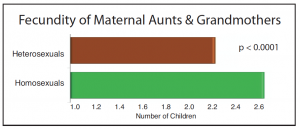
Source: Camperio, Ciani A. and Pellizzari, E. “Fecundity of Paternal and Maternal Non-Parental Female Relatives of Homosexual and Heterosexual Men.” PLoS One, 2012.
later-born males, even when these siblings have been reared apart in different households. In contrast, older, non-biological brothers (step-brothers and adoptive brothers) have no effect on sexual orientation, indicating this association is not a result of the family environment during childhood. This finding has been seen in modern as well as traditional cultures. Furthermore, sexual orientation of females is not influenced by this so-called fraternal birth order effect, and sisters do not add to the effect. The correlation pertains only to male siblings who have been gestated in the same woman’s uterus. All of these findings point toward a prenatal epigenetic origin for the fraternal birth order effect. This appears to be mediated via the maternal immune system.
Among the prenatal influences of male homosexuality, the fraternal birth order effect is the most robust and replicated finding. Each son raises the relative probability of homosexuality in the following son by 33 percent (Blanchard 2004). Although these increased odds may seem outsized, they are relative to a baseline rate of homosexuality of about two percent for a first son; the probability of having a gay son reaches fifty percent only after ten older biological brothers. Thus, the fraternal birth order effect explains only about fifteen to 29 percent of the male homosexual demographic.
The leading hypothesis for the mechanism controlling fraternal birth order effect is progressive immunization of mothers to male-specific antigens while carrying a male fetus, with increasingly higher levels of anti-male antibodies with each successive pregnancy (Bailey, 2016). Eventually, this can affect in-utero sexual differentiation of the brain in later-born males. The process appears to be mediated by a maternal immune response to Y-linked histocompatibility antigens. Homosexuality, in this way, is a natural response to environmental signals in the mother’s womb, an evolutionary adaptation that is effectively a natural method of birth control at the family level.
The second line of research has linked male homosexuality to prenatal stress. A male fetus whose mother endured high levels of stress during the pregnancy is more likely to be homosexual or bisexual. Observational studies suggest that environmental and/or psychological stress during prenatal or early postnatal life may increase the likelihood of male homosexuality in humans (VanderLaan, 2011). Experimental data has shown similar findings in rodents. In a case-control study, 100 homosexual or bisexual males were compared to 100 heterosexual males with respect to the level of stress in their mothers’ lives during pregnancy, as ascertained by interviews with the study participants and their parents. This study was conducted in Germany about forty years after World War II ended, and thus many of the reported stresses were related to undesired pregnancies and war atrocities. During their pregnancies, the mothers of gay men suffered severe stress significantly more often than the mothers of heterosexual men (Figure 2).
Neuropsychological Differences
Homosexual males, as compared to heterosexual males, display significantly less physical aggression and hostility. Gay men have also been reported to have generally a greater capacity for kindness, cooperativeness, and sensitivity. Compared to heterosexual males, homosexual males tend to score significantly higher on psychometric testing of empathy, which is strongly linked to altruism. A recent study found that among both men and women, homosexuality tends to promote emotional connectedness (Fleischman, 2014). In another study using the empathizing quotient (EQ)—a sixty-item scale used to assess empathy in participants by measuring emotional reactions—Mark Sergeant and his team reported that homosexual males consistently exhibited higher levels of empathy compared to heterosexual males (Sergeant, 2004).
Studies report that homosexual men outperform heterosexual men on standardized tests of verbal skills. A comprehensive statistical analysis of three large, nationally representative, longitudinal databases from the U.S. and the UK found strong associations between childhood intelligence and subsequent adult homosexuality. More intelligent children as compared to less intelligent children are subsequently more likely to self-identify as gay as adults, to express same-gender sexual attraction (Figure 3a), and to have had significantly more same-gender sexual partners during their lifetimes (Figure 3b). These analyses found that homosexual individuals tend to be more intelligent from an early age, suggesting that these two traits may be linked from birth.
Conversely, gay men compared to straight men generally possess a less accurate innate sense of direction and tend to navigate by using landmarks rather than instinctive directional orientation—a navigational style that has been shown to be more common among women, as well.
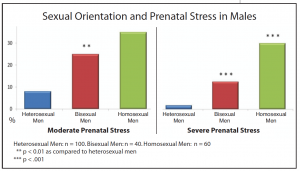
Source: Dorner, G., et al. “Stressful Events in Prenatal Life of Bi- and Homosexual Men.” Experimental and Clinical Endocrinology, 1983 (81).
Studies have highlighted structural brain differences between heterosexual and homosexual males, particularly in the anterior hypothalamus, and suprachiasmatic nuclei. While the significance of these variations in brain structure between gay and straight males remains largely unknown, and further research on specific receptors and neurotransmitters is needed, the neuro-anatomical divergence does support a biological basis for homosexuality. One study (Zhou, 1995) concluded: “This postnatal period of hypothalamic differentiation indicates that, in addition to genetic factors, a multitude of environmental and psychosocial factors may have a profound influence on the sexual differentiation of the brain.”
Kin Selection Theory of Homosexuality
“Homosexuality is not a reproductive strategy; it is a survival strategy,” remarked R. C. Kirkpatrick (2000). Classically, an organism achieves evolutionary success by sexual reproduction. Alternatively, inclusive fitness, also referred to as kin selection, is another strategy for successfully transmitting one’s genes to the next generation. A parent and child share fifty percent of their genes, as do a brother and sister; an uncle shares 25 percent of his genes with each of his nieces and nephews. From a mathematical perspective, an individual can achieve the same genetic success by raising one offspring or helping to ensure that a sibling successfully raises two offspring. J. B. S. Haldane (1955), who pioneered the mathematics of kin selection, famously quipped: “Would I lay down my life to save my brother? No, but I would to save two brothers or eight cousins.”
Thus kin selection is an evolutionary strategy favoring the reproductive success of an individual’s close relatives, sometimes despite the loss of that individual’s own reproduction and/or survival. Kin selection drives the evolution of altruistic behavior toward relatives, a phenomenon known as kin altruism. Kin selection appears to involve both epigenetic and genetic mechanisms that are transmitted indirectly via the lineage of siblings and other close relatives. According to Eva Jablonka (2015), a geneticist and theorist: “Sex is not always tied to reproduction. Instead, it is about something even more fundamental—the maintenance of DNA.” Similarly, a genetic variation that predisposes one to homosexuality could possibly foster the maintenance of a family’s genetic line despite its tendency to reduce the affected individual’s chances of reproducing and having offspring of their own.
The male homosexuality trait, despite its tendency to significantly reduce a man’s fertility, may persist because gay males help make their families more functional and resilient by improving emotional interconnectedness. Homo sapiens is among the most social of species, and survival of the fittest involves more than just a single person; it is the social unit that survives. Superior verbal reasoning skills, higher levels of empathy, and lower levels of physical aggression—traits found more commonly in homosexuals than in their heterosexual counterparts—can promote improved fitness and strength of the family as a unit. By improving the functionality of the group, gay males could help their siblings reproduce more successfully and improve the viability of their nieces and nephews in harsh ancestral environments. In this instance, gay males subconsciously display kin altruism by forgoing their reproductive success in the setting of a large number of older brothers or when born to especially fertile mothers. In these scenarios, male homosexuality could have evolved as a form of birth control to limit overpopulation in settings where more offspring might endanger the welfare of the family by overburdening the clan with yet more mouths to feed.
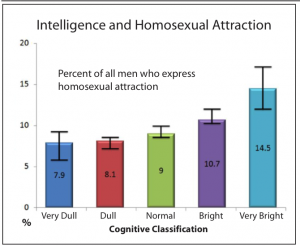
Furthermore, male homosexuality could help reduce counterproductive competition among male siblings and cousins for female mates. It is possible that homosexuality could be epigenetically induced in male fetuses in times of increased stress. Instead of adding more family members by reproducing directly, a gay male may be endowed with a suite of emotional qualities that help support emotional bonding and group cohesiveness, thereby improving the family unit’s resilience to stress.
This kin selection theory of homosexuality, as originally proposed by E. O. Wilson forty years ago, postulates that the reproductive penalty imposed by homosexuality must be offset by improved chances that the siblings of a gay individual will successfully reproduce and their nieces and nephews will survive. Subsequent studies of this hypothesis have yielded conflicting data. Studies from the U.S. in 2001 (Bobrow) and England in 2005 (Rahman) reported that homosexual males compared to heterosexual males were not found to have a significantly higher level of familial affinity, generosity to family members, or benevolent tendencies to their siblings. However, in many modern societies, homosexual males have been ostracized from their families for being openly gay, which could interfere with natural altruistic tendencies they might otherwise feel toward their relatives.
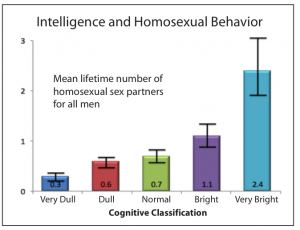
Source: Kanazawa, S. “Intelligence and Homosexuality.” Journal of Biosocial Science, 2012 (44).
In contrast, a study of the natives of Samoa provided a test of the kin selection hypothesis of homosexuality in a cultural milieu more congruent with the environment in which humans evolved. Homosexual males (referred to as fa’afafine) in this traditional culture play an integral role in their families, providing emotional support and nurturing behavior for siblings, nieces, and nephews. In a scientific assessment of this population (Vasey, 2007), the homosexual men were more likely than heterosexual men to display avuncular behavior, and showed significantly more kindness and generosity to their extended families, particularly to the nieces and nephews.
Implications
The scientific understanding of the biology of sexual orientation is still in a nascent stage. Studies strongly suggest homosexuality is influenced by genetics and epigenetics, but the specific genes and epi-tags have yet to be clearly elucidated. Still, enough of the pieces of the puzzle of homosexuality are now visible to begin to see a pattern. Male homosexuality appears to have arisen via human evolution because of its potential benefits for the functionality and survivability of the family. Due to a specific suite of traits, largely determined in utero, gay males could provide diversity and stability to their families and in-groups. In addition, male homosexuality also reduces population pressures at a family level in certain scenarios in which this is likely to be beneficial—in settings such as multiple older brothers, large families, and/or highly stressful environments.
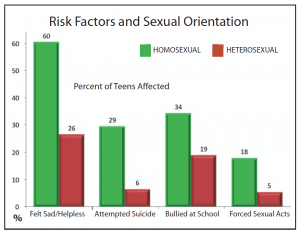
Source: Kann L., et al. “Youth Risk Behavior Surveillance: United States, 2015.” Morbidity and Mortality Weekly Report, 2016 (65).
Homosexuality is increasingly understood as having a biological cause, and in many cultures the gay community has made substantial progress on legal and social acceptance. And yet, individuals in the sexual minority remain targets for bigotry and bullying. The U.S. Centers for Disease Control and Prevention recently published a nationally representative survey that polled 15,500 U.S. high school students about their sexual orientation and several aspects of well-being. The disturbing results of that survey are depicted in Figure 4.
Currently, in many countries around the world, same-sex physical intimacy is punishable by death or imprisonment, and gays are often the victims of violence and discrimination. Just recently, the United Nations passed a resolution condemning the use of the death penalty for consensual gay sexual relations. Shockingly, the UN delegation from the U.S. voted against this resolution—which passed nevertheless. The emerging understanding of the biology of sexual orientation indicates that same-sex sexual preference is a naturally intended, normal variant that evolved via kin selection, and thus it should not be considered illegal or emotionally depraved. Indeed, homosexuality appears to be an evolutionary adaptation to help safeguard the family’s well-being—an altruistic purpose.
Further research is needed to form a better understanding of the evolutionary advantages of homosexuality, and more studies focused on females are needed. The elucidation of the scientific underpinnings of homosexuality will require an interdisciplinary approach using genetics, epigenetics, and evolutionary biology, along with neuroscience, anthropology, psychology, and biomedical sciences.
References
Bailey, J.M., et al. “Sexual Orientation, Controversy, and Science.” Psychological Science in the Public Interest, 2016 (17).
Blanchard, R. “Quantitative and Theoretical Analyses of the Relation between Older Brothers and Homosexuality in Men.” Journal of Theoretical Biology, 2004 (230).
Bobrow, D. and Bailey, J.M. “Is Male Homosexuality Maintained Via Kin Selection?” Evolution and Human Behavior, 2001 (22).
Fleischman, D.S., et al. “Testing the Affiliation Hypothesis of Homoerotic Motivation in Humans: The Effects of Progesterone and Priming.” Archives of Sexual Behavior, 2015 (44).
Haldane J.B.S.. “Population Genetics.” New Biology, 1955 (18).
Jablonka, E. and Lamb, M.J. Evolution in Four Dimensions: Genetic, Epigenetic, Behavioral, and Symbolic Variation in the History of Life. Cambridge, 2005.
Kirkpatrick, R.C., et al. “The Evolution of Human Homosexual Behavior.” Current Anthropology, 2000 (41).
Ngun, T. C., and Vilain, E. “The Biological Basis of Human Sexual Orientation: Is There a Role for Epigenetics?” Advanced Genetics, 2015 (86).
Rahman, Q. and Hull, M.S. “An Empirical Test of the Kin Selection Hypothesis for Male Homosexuality.” Archives of Sexual Behavior 2005 (34).
Reardon, S., et al. “Epigenetic Tags Linked to Homosexuality in Men.” Nature, October 2015.
Sanders, A.R., et al. “Genome-Wide Scan Demonstrates Significant Linkage for Male Sexual Orientation.” Psychological Medicine, 2015 (45).
Sergeant M.J.T., et al. “Aggression, Empathy and Sexual Orientation in Males.” Personality and Individual Differences, 2006 (40).
VanderLaan D.P. and Vasey, P.L. “Male Sexual Orientation in Independent Samoa: Evidence for Fraternal Birth Order and Maternal Fecundity Effects.” Archives of Sexual Behavior, 2011 (40).
Vasey, P.L., et al. “Kin Selection and Male Androphilia in Samoan Fa’afafine.” Evolution and Human Behavior, 2007 (28).
Wilson, E.O. The Social Conquest of Earth. Liveright Publishing Corp., 2012.
Zhou J.N., et al. “A Sex Difference in the Human Brain and Its Relation to Transsexuality.” Nature, 1995 (378).
James O’Keefe has authored or co-authored 360 medical articles, including many on evolution and human health. His TED Talk summing up this research has been viewed over one million times.
Evan O’Keefe, a third-year medical student, has published on global health, human evolution, and prevention of cardiovascular disease.
John Hodes, a pre-med student at Marquette University, has conducted research on belonging and its connection to mental health.


